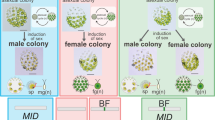Abstract
Eukaryotic sex was initially isogametic and it is assumed that anisogamy/oogamy evolved independently in many lineages including animals, land plants and volvocine green algae. The exact evolutionary mechanisms that were responsible for the evolution of oogamy from isogamy were poorly understood until Nozaki et al. (2006) introduced the use of molecular-genetic data in elucidating the evolutionary origin of oogamy from isogamy in the colonial volvocacean Pleodorina starrii. In the close relative Chlamydomonas reinhardtii, sexual reproduction is isogametic with mating-types plus and minus. Mating type minus represents a “dominant sex” because the MID (“minus-dominance”) gene of C. reinhardtii is both necessary and sufficient to cause the cells to differentiate as isogametes of the minus mating type. No sex-specific genes had been identified in the volvocine green algae until Nozaki et al. (2006a) successfully cloned the MID gene of P. starrii. This “OTOKOGI” (PlestMID) gene is present only in the male genome, and encodes a protein localized abundantly in the nuclei of mature sperm. Thus, P. starrii maleness evolved from the dominant sex (mating type minus) of its isogamous ancestor. This breakthrough provides an opportunity to address various extremely interesting questions regarding the evolution of oogamy and the male-female dichotomy.
Similar content being viewed by others
References
Adams C.R., Stamer K.A., Miller J.K., McNally J.G., Kirk M.M. & Kirk D.L. 1990. Patterns of organellar and nuclear inheritance among progeny of two geographically isolated strains of Volvox carteri. Curr. Genet. 18: 141–153.
Boynton J.E., Harris E.H., Burkhart B.D., Lamerson P.M. & Gillham N.W. 1987. Transmission of mitochondrial and chloroplast genomes in crosses of Chlamydomonas. Proc. Natl. Acad. Sci. USA 84: 2391–2395.
Coleman A.W. 1975. Long-term maintenance of fertile algal clones: experience with Pandorina (Chlorophyceae). J. Phycol. 11: 282–286.
Ferris P.J., Armbrust E.V. & Goodenough U.W. 2002. Genetic structure of the mating-type locus of Chlamydomonas reinhardtii. Genetics 160: 181–200.
Ferris P.J. & Goodenough, U.W. 1994. The mating-type locus of Chlamydomonas reinhardtii contains highly rearranged DNA sequences. Cell 76: 1135–1145.
Ferris P.J. & Goodenough U.W. 1997. Mating type in Chlamydomonas is specified by Mid, the minus-dominance gene. Genetics 146: 859–869.
Ferris P.J., Pavlovic G., Fabry S. & Goodenough U.W. 1997. Rapid evolution of sex-related genes in Chlamydomonas. Proc. Natl. Acad. Sci. USA 94: 8634–8639.
Karol K.G., McCourt R.M., Cimino M.T. & Delwiche C.F. 2001. The closest living relatives of land plants. Science 294: 2351–2353.
Kirk D.L. 2006. A twelve-step program for evolving multicellularity and a division of labor. BioEssays 27: 299–310.
Kuroiwa H., Nozaki H. & Kuroiwa T. 1993. Preferential digestion of chroroplast nuclei in sperms before and during fertilization in Volvox carteri. Cytologia 58: 281–291.
Kuroiwa T., Kawano S., Nishibayashi S. & Sato C. 1982. Epifluorescent microscopic evidence for maternal inheritance of chloroplast DNA. Nature 298: 481–483.
Lahn B.T. & Page D.C. 1999. Four evolutionary strata on the human X chromosome. Science 286: 964–967.
Mori F., Erata M. & Watanabe M.M. 2002. Cryopreservation of cyanobacteria and green algae in the NIES-Collection. Microbiol. Cult. Coll. 18: 45–55.
Nozaki H. 1996. Morphology and evolution of sexual reproduction in the Volvocaceae. (Chlorophyta). J. Plant Res. 109: 353–361.
Nozaki H. 2003. Origin and evolution of the genera Pleodorina and Volvox (Volvocales). Biologia 58/4: 425–431.
Nozaki H. 2008. Zygote germination in Pleodorina starrii (Volvocaceae, Chlorophyta). Biologia 63: DOI: 10.2478/s11756-008-0098-8.
Nozaki H. & Ito M. 1994. Phylogenetic relationships within the colonial Volvocales (Chlorophyta) inferred from cladistic analysis based on morphological data. J. Phycol. 30: 353–365.
Nozaki H., Misawa K., Kajita T., Kato M., Nohara S. & Watanabe M.M. 2000. Origin and evolution of the colonial Volvocales (Chlorophyceae) as inferred from multiple, chloroplast gene sequences. Mol. Phylog. Evol. 17: 256–268.
Nozaki H., Mori T., Misumi O., Matsunaga S. & Kuroiwa T. 2006a. Males evolved from the dominant isogametic mating type. Curr. Biol. 16: R1018–R1020.
Nozaki H., Ott F.D. & Coleman A.W. 2006b. Morphology, molecular phylogeny and taxonomy of two new species of Pleodorina (Volvoceae, Chlorophyceae). J. Phycol. 42: 1072–1080.
Rokas A., Krüger D. & Carroll S.B. 2005. Animal evolution and the molecular signature of radiations compressed in time. Science 310: 1933–1938.
Schauser L., Wieloch W. & Stougaard J. 2005. Evolution of NIN-like proteins in Arabidopsis, rice, and Lotus japonicus. J. Mol. Evol. 60: 229–237.
Author information
Authors and Affiliations
Corresponding author
Rights and permissions
About this article
Cite this article
Nozaki, H. A new male-specific gene “OTOKOGI” in Pleodorina starrii (Volvocaceae, Chlorophyta) unveils the origin of male and female. Biologia 63, 772–777 (2008). https://doi.org/10.2478/s11756-008-0097-9
Received:
Accepted:
Published:
Issue Date:
DOI: https://doi.org/10.2478/s11756-008-0097-9




